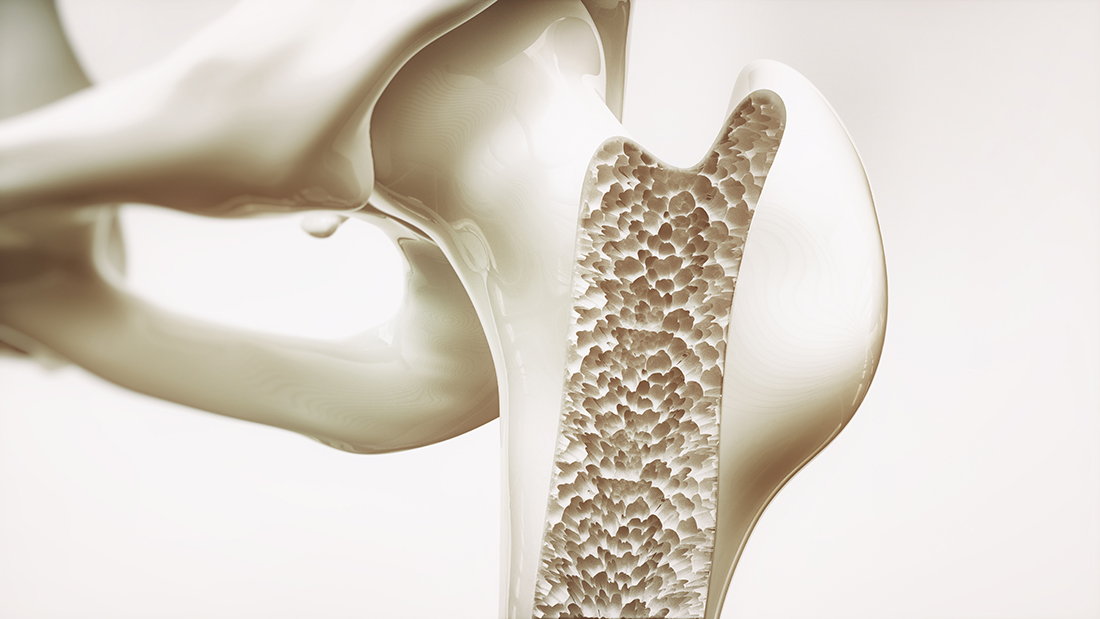
What is Osteoporosis?
Osteoporosis is a bone disease that causes bone to become weaker and easily broken. Normally the inside of a bone is like a dense honeycomb. Osteoporotic bone is less dense and has more ‘holes’ than normal bone. The problem is that often you won’t know whether you have osteoporosis until after you break a bone, which is why osteoporosis is called the ‘silent disease’. Sometimes people with osteoporosis have bones that are so brittle that coughing or bending over can cause a fracture. Osteoporotic fractures (so called ‘fragility fractures’) occur most commonly occur in the hip, wrist, shoulder or spine, with hip fractures having the most severe consequences (up to 1 in 3 patients with a hip fracture may die in the following year).
Who gets Osteoporosis?
Risk factors include increasing age, female gender, white or Asian race, a previous fracture, smoking, excessive alcohol intake, low body weight, use of corticosteroids*, early menopause, low calcium intake, and certain medications and medical conditions which affect calcium ‘metabolism’ (how calcium is absorbed, stored, used and excreted by the body).
How do I get Screened for Osteoporosis?
If you think you (or a relative) are at risk for osteoporosis there are several self screening tools available online e.g. from the International Orthopaedic Foundation and The Osteoporosis Self-Assessment Tool for Asians (OSTA). If you are concerned regarding osteoporosis you should speak to your doctor who will assess your risk of osteoporosis and may arrange a Bone Mineral Density (BMD) scan which is quick and painless. Your overall fracture risk can then be calculated using the FRAX online tool. Your doctor may also arrange blood tests (for example to check your Vitamin D, kidney and liver function and hormones which control calcium metabolism) and exclude any underlying medical conditions.
How is Osteoporosis treated?
Prevention is better than cure. Good nutrition and exercise are important to keep bone healthy. Taking enough calcium and Vitamin D is also important to keep bones strong. In Singapore the recommended daily intake for for calcium is 1000mg and 400IU of vitamin D for all adults aged 51-70 years old. Those over 70 years should increase their vitamin D intake to 800IU daily. Weight bearing, high impact, and resistance exercises have been shown to be effective in increasing bone mineral density in women and should ideally be performed for an hour a day, at least three times a week.
Cutting down and ideally stopping cigarette and alcohol consumption will definitely help reduce the risk of osteoporosis.
Your doctor may discuss drug treatment of osteoporosis if your fracture risk is high and once certain underlying medical conditions have been excluded. There are variety of medications available to treat osteoporosis. Your doctor should discuss with you the pros and cons of such medication and which is suitable for you. It is beyond the scope of this article to discuss all side effects of each drug, but it is important to have an adequate intake of calcium and vitamin D whilst taking any medication, and to be followed up on a regular basis to exclude any potential side effects.
Regarding surgical treatment – operating on fragile osteoporotic bone can be a challenge for the orthopaedic surgeon. Fortunately modern surgical implants have been designed for better fixation and ‘hold’ in osteoporotic bone. Looking after an elderly patient with a hip fracture is a multidisciplinary team effort involving geriatricians, physiotherapists, occupational therapists, nursing staff and many more. Months of rehabilitation may be required before the patient is well enough to return home.
Final Thought
Fortunately awareness and understanding of Osteoporosis is increasing, which is important as Singapore is estimated to have a life expectancy of 92 by the year 2050, and almost half the population expected to be over 50 years old. Hopefully by then osteoporosis will no longer be the silent disease it once was.
*taking more than 5 mg/day prednisolone or equivalent for 3 months or longer







